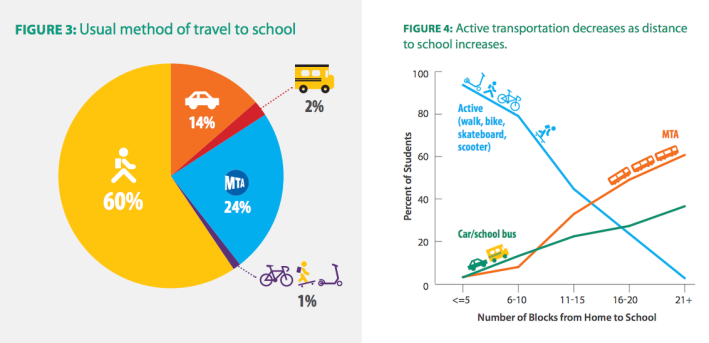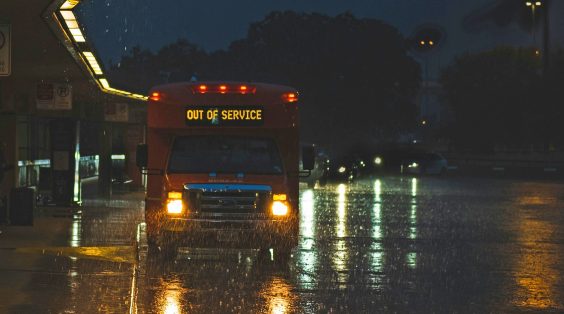
Just one percent of sixth-graders surveyed at 15 schools in Brooklyn, Manhattan, and the Bronx said they get to class by bike, scooter, or skateboard, according to a survey released by the Department of Health and Mental Hygiene last week [PDF]. Although most students live within walking distance of school, many of them take buses or cars to get to class. The report's implication is clear: The rate of walking and biking to school in NYC may be far higher than other parts of the country, but there's plenty of room for improvement.
The survey, first reported by Capital New York, is from the newly-formed Center for Health Equity, funded with $3.2 million in the de Blasio administration's executive budget to address public health problems that disproportionately affect communities of color. The health department surveyed 1,005 sixth-graders, 24 parents, and principals at 15 schools in East Harlem, Bedford Stuyvesant, Bushwick, Highbridge, and Morrisania. It is not a representative sample of all NYC students, but it shows how kids get to school in walkable areas where most people are in the habit of getting around without driving.
Although 75 percent of students live within 20 blocks of school (about a mile), not all of these kids walk or bike to class. About 60 percent of all students said they walk, and just one percent arrive by bike, scooter, or skateboard. Nearly four in ten students don't walk or bike, with 24 percent taking an MTA bus or subway, 14 percent being driven to school, and two percent riding a yellow school bus.
While a 61 percent mode share for active transportation might sound good compared to a national average of 13 percent, there's a lot of room for improvement. The schools surveyed are located in zip codes that had a Walk Score greater than 85 out of 100, placing them in some of New York's more walkable neighborhoods.
It's hard to say how these numbers compare to other NYC schools because students and parents are rarely surveyed on travel choices. DOT said that in the relative handful of schools it works with directly, it typically finds that three-quarters of elementary students walk to school. At most middle and high schools, three-quarters of students walk or take transit. As with the DOHMH study, DOT said bike-to-school numbers barely register.
In the survey, bike- and walk-to-school rates fell steeply as distance from school increased -- even at walkable distances like 11 blocks, or about half a mile. Within five blocks of school, 94 percent of students walk or bike. Between six and 10 blocks, that number falls to 79 percent. It drops to 45 percent for students who live 11 to 15 blocks away and to 24 percent for students 16 to 20 blocks away. Only 3 percent of students who live more than 20 blocks from school walk or bike there, according to the survey.
About 15 percent of students live between 11 and 20 blocks away from school -- distances that are easily walkable or bikeable but where active transportation rates are under 50 percent. About 25 percent of students live more than 20 blocks from school, where biking would be especially useful.
Parents in the focus groups, which were two-thirds women, told the health department that their top concerns are making sure kids get to school quickly and safely. For short distances, active transportation takes the same or less time than other options, though many parents opt for other modes because they are worried about safety. Traffic isn't the only concern, either. Parents said they are also wary of criminal or gang activity, and the potential for bullying or fights with other children.
Parents use a variety of tools to deal with these concerns. Some accompany their kids all the way or part-way to school; others have a "buddy system" with other students at the same school.
When looking at traffic safety specifically, parents said they worry about reckless drivers, dark streets, and the availability of crossing guards. Many said they don't let their kids bike to school because they fear drivers don't respect bike lanes and won't look out for people riding bikes. "Parents also believe that sixth graders are too young and inattentive to ride responsibly," the report says.
"You have delivery trucks, the school buses, people driving their own kids. You are just scared to send your kid off on a bike," a Bronx parent said in one focus group. Students themselves have doubts about street safety, with just 49 percent saying it is safe to walk near their school, and 32 percent saying it is safe to bike around school.
There's another possible reason why bike-to-school rates in NYC are so low: Few schools do much of anything to promote bicycling. The report found that just two of the 15 schools surveyed have a bike rack or safe place for storing bikes, scooters or skateboards during the school day. In addition, only two schools reported hosting an activity that encouraged active transportation in the past year.
"You have to get everybody involved for the child to be able to go, on a bike, to school," said one Brooklyn parent in a focus group. "And the school itself has to have parking for it."
There are city programs to encourage biking and walking to school, but they have a limited reach.
The Brooklyn District Public Health Office has worked with a handful of schools in Brownsville and East New York on bike- and walk-to-school programs, including walking school buses, street safety audits, bicycle mechanics classes, and bicycling clubs.
Today, DOT began accepting applications for its third annual Bike to School program for middle and high schools. Participating schools receive, among other interventions, an in-classroom curriculum, helmet fittings, helmet giveaways, and bike rack installations over a three-year period. DOT will select up to five schools to participate in this competitive program.
Most promising is changing the streets themselves to become safe enough for kids to walk or bike. Last year, Columbia University academics studied DOT's Safe Routes to School program, which adds safety improvements like crosswalks and curb extensions to areas around schools. The study found that traffic injuries to school-age children dropped by a third in areas where the Safe Routes to School program had been introduced.
DOT has secured federal funding to expand the program, but it is far from reaching all of the city's schools. The health department report recommends the de Blasio administration's Vision Zero initiative feature greater interagency collaboration on reducing barriers to walking and biking to school, including a focus on creating new protected bike lanes where young bike riders and their parents feel safe.





